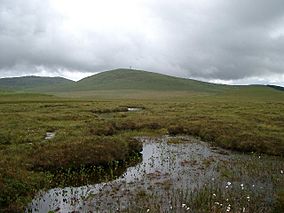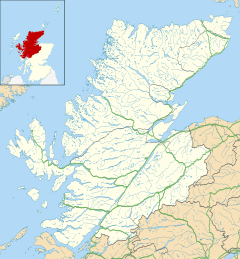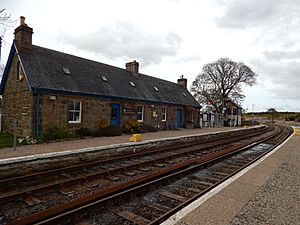Forsinard Flows National Nature Reserve facts for kids
Quick facts for kids Forsinard Flows National Nature Reserve |
|
|---|---|
|
IUCN Category II (National Park)
|
|

Small lochans on the accessible area of the Forsinard reserve
|
|
| Location | Highland, Scotland |
| Area | 153.8 km2 (59.4 sq mi) |
| Designation | NatureScot |
| Established | 2007 |
| Owner | Royal Society for the Protection of Birds (RSPB) |
| Forsinard Flows National Nature Reserve | |
Forsinard Flows is a special place in the Highland area of Scotland. It is a national nature reserve (NNR). This means it is protected to help nature thrive. The reserve is found in the middle of the Flow Country. This is a huge area of peatland and wetland in Caithness and Sutherland. The Flow Country is very important. It has almost 5% of all the world's blanket bog.
The Royal Society for the Protection of Birds (RSPB) looks after Forsinard Flows. It is a Category II protected area. This is a special way to say it's important for nature. Much of this reserve is also part of the Caithness and Sutherland Peatlands Special Protection Area and Special Area of Conservation. These are other ways to protect this amazing habitat.
Contents
Understanding the Unique Blanket Bog Habitat
The Flow Country is home to Europe's largest area of blanket bog. This is a very special type of habitat. Blanket bogs grow in cool, wet places. The soil there is also very acidic. In these conditions, sphagnum moss does not fully rot away. Over thousands of years, the moss and other bog plants build up. They form a layer of peat that can be as deep as 10 meters.
Why Peatlands are Important for Our Planet
Blanket bogs are not just home to many plants and birds. They also help control the amount of carbon dioxide in the air. They act like a giant sponge, soaking up carbon. This helps to slow down climate change. Peatlands hold almost 30% of all the carbon on land. This is amazing, as they only cover 3% of the world's land!
Protecting and Restoring the Flow Country
After the Second World War, people planted many trees on peatland. They were mostly conifers, which are not native to this area. This happened a lot in the 1970s and 1980s. These trees dried out the peat. This harmed the habitat and its wildlife. Since the mid-1980s, it has been against the rules to plant new trees on deep peat.
The RSPB started buying land in the Flow Country in the mid-1990s. They began a huge project to bring the peatland back to life. This is one of the biggest projects of its kind in the UK. The land the RSPB bought now makes up the Forsinard Flows reserve. It was officially named a reserve in 2007.
The RSPB worked hard to remove the trees. They also blocked up the drainage ditches. This helped the water levels return to normal. The work started in 1998. By 2015, the first area they worked on was getting much better. Even though the land still looked a bit bumpy from the old tree rows, it was becoming a healthy blanket bog again.
Amazing Animals and Plants of Forsinard Flows
The peatlands of the Flow Country are very important for certain birds. These include red-throated and black-throated divers. You might also see common scoters. These birds usually live near pools and lochs deep inside the reserve. So, they are not always easy to spot.
Birds You Can See More Easily
Visitors to Forsinard Flows can more easily see other birds. These include golden plovers, dunlins, and greenshank. You might also spot hen harriers, skylarks, and meadow pipits.
Unique Plants and Insects
The area is also known for its special carnivorous plants. These include sundew and butterwort. These plants eat insects! You can also find many aquatic insects here, like dragonflies.
Visiting Forsinard Flows National Nature Reserve
The RSPB has a visitor centre at the old station building. It is located at Forsinard railway station. There is a lookout tower that gives great views over the flat landscape. Two walking trails have been built for visitors to explore the bogland.
Exploring the Trails
The Dubh Lochan Trail is about 1.6 kilometers long. It uses a boardwalk to connect the visitor centre to the lookout tower. This makes it easy to walk on. The Forsinain Trail is longer, about 6 kilometers. It starts about 7 kilometers north of the visitor centre.
Learning and Volunteering Opportunities
The RSPB also has a field studies centre. This centre has classrooms, a lab, and bunkhouse rooms. Groups can stay here for educational trips. They can also come to help with conservation work.



